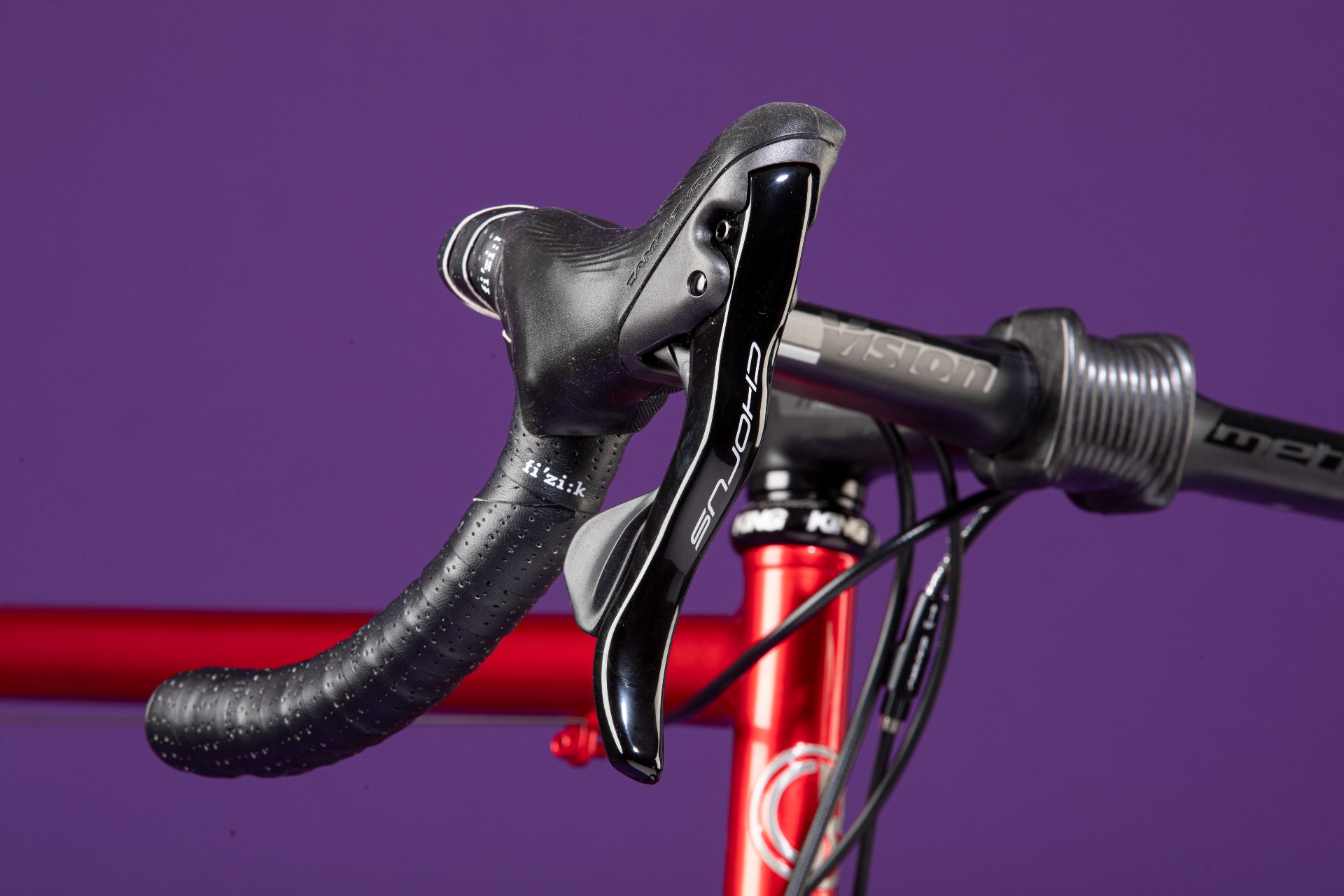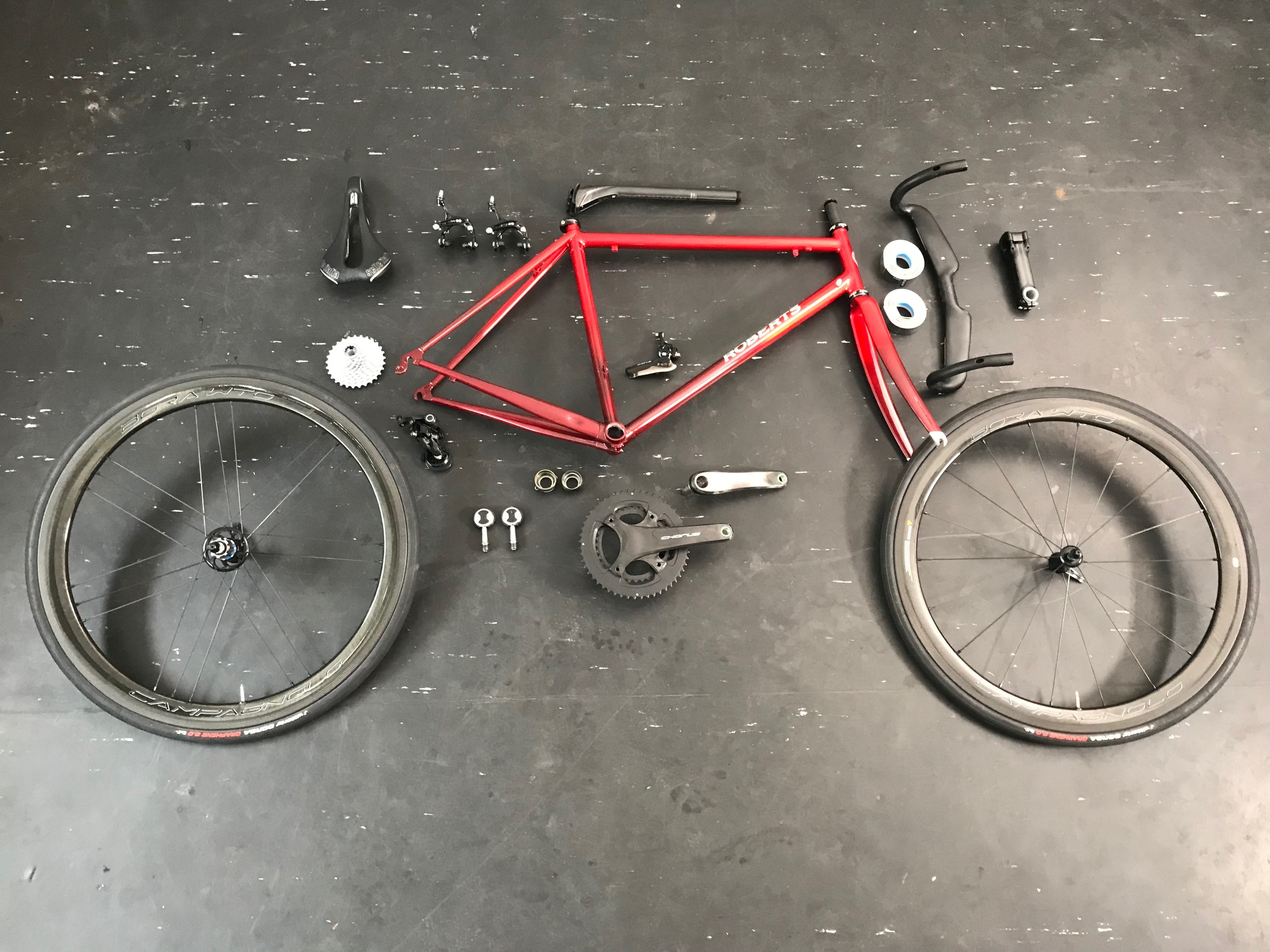Tech team dream builds: Simon Smythe's classic steel Roberts 'restomod'
Tech writer Simon tells how he got hold of this 20-year-old Roberts, gave it a fancy new paintjob and then built it up with some thoroughly modern kit


I ride a lot of carbon bikes in my day job here at Cycling Weekly, but on a Sunday morning when my time is my own you’re more likely to find me heading out on a steel one, with my club, to some far-flung chintzy cafe.
‘Steel is real’ is a bit of a cliche, but I love the idea that the bike I'm riding was made by hand in a small workshop by a local framebuilder instead of popping out of a mould in a huge, anonymous factory on the other side of the world.
And why steel? Well, it's said that steel is the benchmark for ride quality and every other material aims to copy it while making it lighter like carbon, or stiffer like aluminium.
In my opinion some of the nicest steel frames were made by Roberts in Croydon from the 1960s until 2015 when they closed, so when a clubmate of mine said he wanted to get rid of his Roberts I was knocking on his door virtually before he’d even finished typing the WhatsApp message.
I’m a massive fan of Roberts - the quality of the workmanship is legendary; you’ve never seen such beautiful fillet-brazed joints. I already own a Roberts tourer but I really wanted one for faster-paced riding.
My clubmate had the frame made to measure in 2000 out of Columbus Max tubing, the stiffest there was. It was built as a race bike, as you can see from the number peg.
The frame weight of just over 2kg seems ridiculously heavy by today's standards, but I wasn't planning to race it - as a 'cafe racer' for pacey club runs it doesn't really matter if it weighs a bit more than a carbon bike. If you get dropped they wait (hopefully). And it's always a handy excuse to have up your sleeve in any case.
The latest race content, interviews, features, reviews and expert buying guides, direct to your inbox!

The Roberts started out navy, then was resprayed orange after it rusted in a box in his garden when Andy moved to Dubai, then plain black, and when I went to see it there were unpleasant brown patches spreading across it from sitting in his garage - it badly needed rescuing.
So I took it to Colour-Tech in Dartford to be blasted and resprayed by Dave Crowe, who actually used to paint frames for Roberts themselves and whose work I really rate.

I asked Dave to copy a Trek Project One fade scheme that I liked and I think it came out looking even better than the Trek.

He used automotive 2-pack acrylic enamel - wine red at the bottom fading into candy red at the top over a metallic base. It’s a beautiful job - and it cost £200 to do the frame and the Columbus carbon fork, which I think is a fair price for bringing a frame like this back to life.
The groupset
Yes, the frame is 21 years old but I didn’t want to build it up as some kind of period-correct museum piece with NOS components I’d painstakingly sourced on Ebay. I wanted a modern groupset with modern ratios because it’s going to be a bike I actually ride. But it did need something a bit special - and although Shimano is functionally amazing, there’s no doubt about that, only a Campagnolo groupset would do.

I went for a full mechanical Campagnolo Chorus groupset. I think the latest rim brake, mechanical Chorus looks really classy. The nude carbon marbled finish on the chainset goes perfectly with the frame and the white logos match the frame decals nicely.
Chorus is high end but not priced ridiculously high - about £1,250 and a little bit more expensive than Ultegra and £600 cheaper than Record. It’s aimed at keen amateurs rather than pros and doesn’t even come in a 53/39 racing chainset option - 52/36 is the biggest there is - so it’s ideal for this cafe racer setup.
I went for the 11-29 cassette, which again are the raciest ratios in the Chorus line-up, but I’m confident it’s enough for any hill in Surrey, and certainly the bottom gear is much lower than the one this bike would have had originally.

Modern handmade steel bikes have to have a Chris King headset. They’re said to last a lifetime and this one actually is already pretty old. It’s an original 1" NoThreadSet. I swapped it with a friend who is a fellow Roberts owner. They come in a lot of pretty colours but black works well here - and it was the only one he had anyway.
The wheels
A Campagnolo groupset deserves Campagnolo wheels and the Bora WTO 45s are my favourites at the moment. They’re aerodynamic with a 45mm rim depth, lightweight at just under 1,500g and have a 19mm rim width. That’s wider than the skinny wheels that the Roberts would have rolled on 21 years ago but there’s just enough clearance with 25mm Vittoria Corsa Graphene 2.0s. Anyway, in those days, fag paper clearance was what a fast bike was all about. The list price is just under £2,000 for these wheels.
The finishing kit
The Vision Metron Aero bar is quite statementy and very expensive at £350, but this is a dream build, after all. It’s comfortable, aerodynamic and light at 250g. The aero tops might upset the purists who would rather see a traditional round-section bar on a bike like this, but it's a risk I'm willing to take.

The Vision Trimax Carbon stem is actually aluminium with a carbon skin but the finish matches the Metron bar - and this cover has the look of Alien about it. I’ve had to use a shim because it's for 1 1/8in steerers and the Roberts’s Columbus fork has a 1in steerer.

The Vision Metron seatpost is another component from Vision’s top-level range and another money-no-object item at over £200.
The saddle - I’ve gone with what works for me rather than something showy, but it’s still very nice: the Selle Italia SLR Superflow. It has the standard manganese rails and that’s fine by me. I have a couple of these saddles and put them on the bikes I ride most regularly.
I used to insist on a white saddle and white bar tape for my race bikes but I don’t want to divert attention away from this bike’s classy frame and chic groupset and wheels - that would be gilding the lily - so this time the saddle and black Fizik bar tape are designed to just blend in.
I’m using the new Wahoo Speedplay Zero pedals. I like the look of these, the free-feeling float and even the sound of clipping in and out.
The build

It all came together really nicely when we built it in the workshop. One of the nice things about old-school external cable routing is that it’s easy to build and of course easy to maintain. And now that you don’t see full cable runs so frequently, you don’t appreciate how elegant they can be. If you get it right you can have curving shapes that actually complement a straight-tubed bike. Why would you want to hide them?

I’m not going to do a rim v disc brakes argument here, but with external brake cables you can do little tricks like cutting them especially so that the word Campagnolo is on display. You might have better braking with a disc bike but you don't have little silver Campagnolo lettering on your cables.

Just one thing went wrong: the Campagnolo chain connector pin has to be pressed in really carefully or you snap it... which is what I did. To get it up and running quickly I got a SRAM Eagle PowerLock link, which doesn't match the Campy chain with its oilslick rainbow finish, but it's a sight easier to fit and works fine.
And the other thing was the Fizik logo that revealed itself when I looped the tape around the bars. Something a little editing with a Sharpie should fix - easier than replacing it.
I chose every component myself for this bike so in theory I knew what it would look like, but it surpassed my expectations.
It’s also much lighter than I thought it would be - it’s just under 8.2kg, under 18lb in old money, which is pretty impressive for a steel frame that was made over 20 years ago. And it also means that I won't be as disadvantaged as I thought I would be when I first discovered the frame weighed over 2kg. But, as I said, this bike is not for racing - it's for enjoying.
The all-up cost was somewhere in the region of £4,500, with almost half of that in the wheels, so admittedly a restomod like this is not a money-saving exercise.
Everybody loves a new bike day, but if you're willing to spend a similar amount of money restoring and modernising an old one, and have the time to spare for getting the parts together and building it, for me that's infinitely more rewarding.

The first ride wasn't a clubrun to a cafe. I was so impressed with this bike that I decided to take it out to a club evening TT. It was a beautiful evening with the sun glinting off the pristine metallic red paint and the Roberts was universally admired - and even recognised, with some amazement, as 'Andy Critchlow's old bike'.
Five, four, three, two, one and off I rode into the sunset for the perfect movie ending - and even better, I was back a few seconds sooner than I expected for a celebratory pint.
| Roberts restomod spec | Header Cell - Column 1 | Header Cell - Column 2 |
|---|---|---|
| Frame | Roberts Columbus Max | Row 0 - Cell 2 |
| Fork | Columbus full carbon 1in | Row 1 - Cell 2 |
| Groupset | Campagnolo Chorus | Row 2 - Cell 2 |
| Wheels | Campagnolo Bora WTO 45 | Row 3 - Cell 2 |
| Tyres | Vittoria Corsa Graphene 2.0 25mm | Row 4 - Cell 2 |
| Bar | Vision Metron Aero | Row 5 - Cell 2 |
| Stem | Vision Trimax Carbon | Row 6 - Cell 2 |
| Seatpost | Vision Metron Aero | Row 7 - Cell 2 |
| Saddle | Selle Italia SLR Superflow | Row 8 - Cell 2 |
| Weight | 8.18kg | Row 9 - Cell 2 |
Simon Smythe is a hugely experienced cycling tech writer, who has been writing for Cycling Weekly since 2003. Until recently he was our senior tech writer. In his cycling career Simon has mostly focused on time trialling with a national medal, a few open wins and his club's 30-mile record in his palmares. These days he spends most of his time testing road bikes, or on a tandem doing the school run with his younger son.
